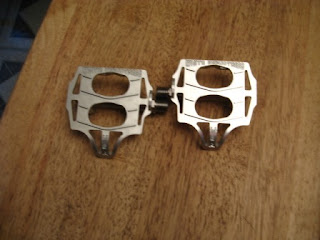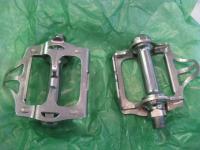 |
| White Industries Urban Platform pedals |
I succumbed to temptation and it arrived today with the guys in brown shirts.
No, I'm not making Nazi porn. (Ironically, it was popular in Israel during the 1960's and is enjoying a resurgence.) What I mean is that amid all those boxes from LL Bean and Macy's, the UPS guys (Yes, they were men.) delivered something I swore I wouldn't buy.
It's a pair of pedals that, even at the lowest online price and with a coupon from the retailer, still cost me more than the first ten or so bikes I owned. But I have a rationale, if not a justification (I believe that, ultimately, humans cannot justify anything.) for my purchase.
On all of my Mercians, I've been riding MKS GR-9 pedals. They're platform pedals, which can be ridden comfortably with any shoes heavier than ballet slippers, at least for a few hours. They're the closest thing I could find to my favorite pedal before I went clipless: the Lyotard No. 23, a.k.a. the Marcel Berthet.
 |
| Lyotard No.23 "Marcel Berthet" Pedal |
I did my first three European tours on those pedals. They enabled me to ride in sneakers or trainers I could wear off the bike. The only other shoes I brought with me were a pair of black cotton Chinese "coolie" shoes. I could wear them with the dark pants and polo shirt I brought with me and get into just about anyplace.
The Berthets were a great design in all sorts of ways. Even though they were made entirely of steel, they were lighter than the alloy Campagnolo pedals and their clones. The bearings weren't as high quality as the ones on the Campy pedals, but they were rebuildable and spun freely. And, did I say they were the most comfortable pedals I've ever ridden?
But today's package didn't contain a pair of them. They can be found on eBay, but the prices for new ones are nearly as high as the lightest carbon and titanium clipless models. That's no surprise, really: Many other longtime cyclists would echo what I said about them, and they've been out of production for about 25 years. Plus, Japanese collectors prize vintage French bikes and parts above all others.
Of course, I could have bought used ones. But a "vintage" with a "patina" might mean that someone crashed it thirty years ago and nobody remembers because it's been sitting in a barn or basement ever since. And that magnifies the one flaw that Berthets had: They weren't the sturdiest of pedals. I broke a few axles on them. Then again, I was riding with, to put it euphemistically, youthful exuberance. And, in a way, it wasn't so terrible to break them, even on my student's budget: They cost about a fifth, if that, of what Campys cost.
 |
| MKS GR-9 |
The main part of the clip attaches slightly below the platform. You can feel it if you're wearing a thin-soled shoe; even with thicker ones, it can create a "hot spot" (though not as severe as the ones on some caged or even clipless pedals).
On the other hand, clips on the Berthet were level with the platform. That is one of the details the White Industries Urban Platform pedal captures:
OK. Now you know the temptation I was describing. I had the chance to try them on someone else's bike and immediately felt the difference. Not only is the platform wider, it seems to be, if not more ergonomic, at least more suited to the foot.
The body looks a lot like the Berthet, except that it's made of a high-strength alumunum alloy. And it has a flip tab that, like the Berthet's, makes entry into toeclips amazingly easy.
But, aside from the superior metallurgy, the WI pedals have another advantage over the Berthets: high-strength stainless steel axles and sealed bearings that spin on them. The latter is another rationale for buying them: On all of my Mercians, the other bearings are sealed. And I've always thought that pedals were the best place on the bike to use sealed bearings.
They're going on Arielle, as it's the bike on which I do my longest rides. But, as finances allow, I'm going to equip my other Mercians with them.























